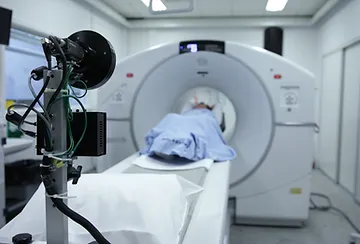
GAMMA KNIFE RADIATION THERAPY FOR PITUITARY TUMORS

Gamma Knife Radiation Therapy for Pituitary Tumors
METHOD FOR DELIVERING FOCUSED RADIATION THERAPY
Gamma Knife radiosurgery is a method for delivering focused radiation therapy to a variety of tumors and lesions in the brain and to pituitary tumors. This discussion will address the general use of Gamma Knife in patients with a pituitary tumor.
Pituitary radiation is usually administered as adjunctive (additional) therapy for patients who have a residual tumor and/or persistent excessive hormone secretion, such as Cushing's Disease, acromegaly, Nelson's syndrome, or prolactinoma.
Pituitary radiation is most commonly administered after surgery or if there is an inadequate response to medical therapy (prolactinoma). The Gamma Knife was developed in 1970 by a neurosurgeon, Dr. Lars Lexsell. With the development of MRI, the dose planning of the radiation field has been modified to improve the accuracy of focusing the radiation field.
The size and location of the tumor are the limiting factors in determining if Gamma Knife radiation is appropriate; the tumor cannot be too close to the optic chiasm (eye nerves) because of the risk of damage to vision. Gamma Knife radiation treatment is usually administered as a single treatment, which requires most of one day. The patient has a stereotactic frame placed on the head, an MRI scan is used to plan the precise field that will be exposed to radiation, and the treatment is given over 1 to 2 hours. Because most pituitary adenomas are benign (non-cancerous), it is thought that a single dose of focused radiation is adequate therapy. Administering the radiation in one session is more convenient for the patient and may be more cost-effective considering the time lost from work. Focused radiation should avoid damage to the hypothalamus (the portion of the brain that regulates the pituitary gland) and other parts of the brain; Gamma Knife exposes a much smaller amount of the brain to radiation, thus decreasing the risks. Because this method of delivering radiation has a very steep fall off of radiation, the optic nerves and optic chiasm are spared from receiving harmful doses of radiation. In some patients, a discrete tumor can be targeted, and the normal gland can be spared from receiving significant radiation. In patients who have persistent excessive hormone secretion but no discrete tumor, the entire pituitary gland is usually targeted for radiation.

Candidates for Gamma Knife Treatment
OFTEN USED FOR SECONDARY THERAPY AFTER SURGERY
Gamma Knife radiation treatment for a pituitary tumor is most often used as secondary therapy after surgery. The size and location of the residual tumor are the limiting factors in selecting a patient for this treatment.
A large pituitary tumor is usually not appropriate for treatment with the Gamma Knife. In some cases, no obvious tumor is seen on the postoperative MRI scan, but the patient still has excessive hormone production, which should be reduced to normal. In this situation, the entire pituitary gland is usually targeted for treatment. Depending on the type of tumor, excessive hormone production after surgery may occur in 20 to 40% of patients. Gamma Knife treatment may also be appropriate for patients who have an initial remission after surgery and then develop a recurrence of excessive hormone secretion.

Results of Gamma Knife Treatment
USED TO TREAT ALL TYPES OF PITUITARY TUMORS
Gamma Knife radiation has been used to treat all types of pituitary tumors and other types of tumors in the pituitary area. At the University of Virginia, during the past eight years, over 270 patients with pituitary tumors have been treated. Treatment results vary according to the type of tumor treated and the method used to plan the radiation field and dose.
One fact about all types of secretory tumors is that complete control of hormone overproduction does not occur immediately. Control of hormone overproduction may take several months to two or three years or more. Additionally, some patients develop new pituitary hormone deficiency, requiring hormone replacement. In comparing the results of conventional, fractionated radiation (usually a daily treatment over 4 to 5 weeks) with Gamma Knife treatment, preliminary results indicate that patients with Acromegaly and Cushing's disease achieve normal hormone levels sooner than patients given conventional, fractionated radiation. Our results in patients with prolactinoma and Nelson's syndrome are less favorable, as are those of other investigators, and the reasons for this are not clear. In patients with non-secretory tumors, shrinkage of residual tumor or control of tumor size has been observed in the large majority of patients. There are no studies comparing the results of Gamma Knife radiation with other methods of focused radiation (proton beam, LINEAC therapy).

Summary
GOAL OF CONTROLLING AND CURING THE PROBLEM
Gamma-focused radiation should be considered part of the pattern of care for patients with secretory and non-secretory pituitary tumors, with the goal of controlling and eventually curing the problem. Part of the comprehensive approach to the care of a patient with pituitary disease is regular endocrine monitoring.
Since there is a risk of developing pituitary hormone deficiency, every patient should be monitored regularly, and appropriate hormone replacement should be instituted if a hormone deficiency develops. Another important part of follow-up is an MRI scan to measure the size of the residual tumor or pituitary gland. Although uncommon, a few patients who have had any type of pituitary radiation may have growth of the tumor, which may require additional surgery. In essence, all patients who have had a pituitary tumor require regular examinations, with particular attention to the need for hormone replacement and regular MRI studies to assess pituitary tumor size. With the proper combination of medical, surgical, and radiation therapy, patients with a pituitary tumor should be able to lead a normal life and have a normal life expectancy.




